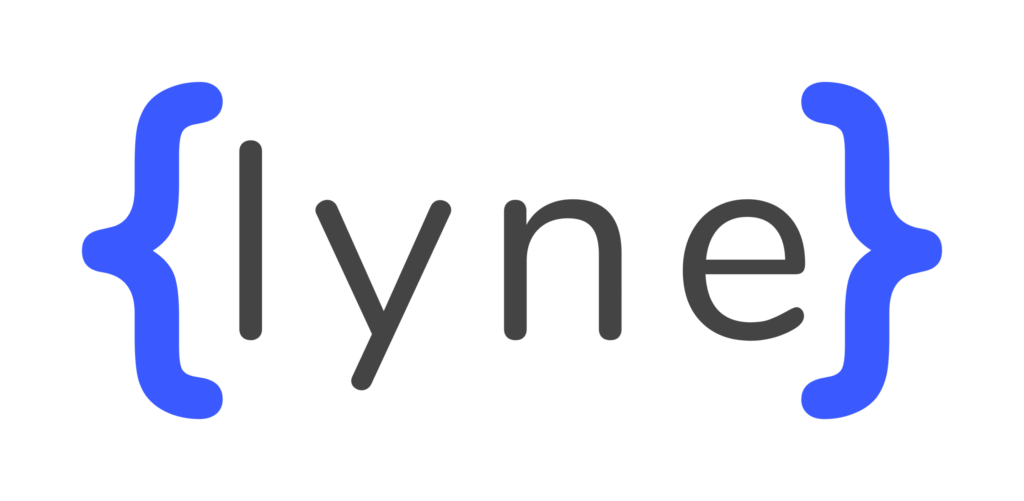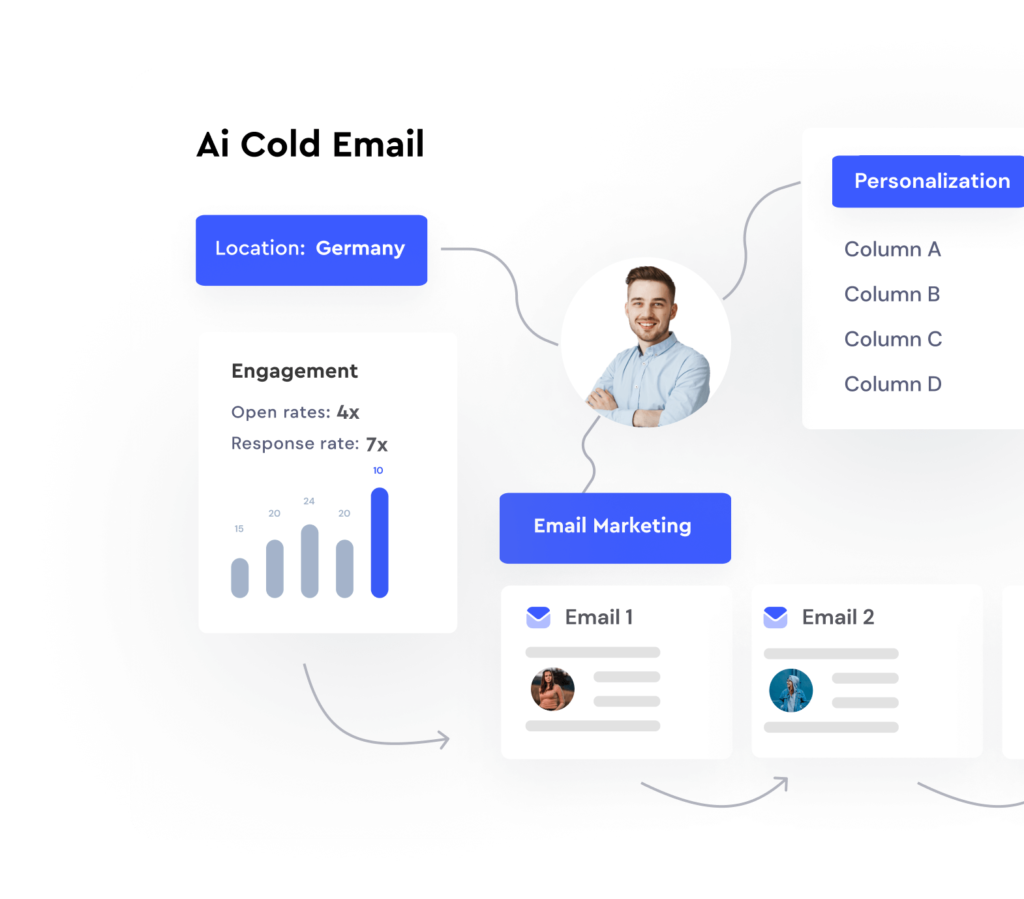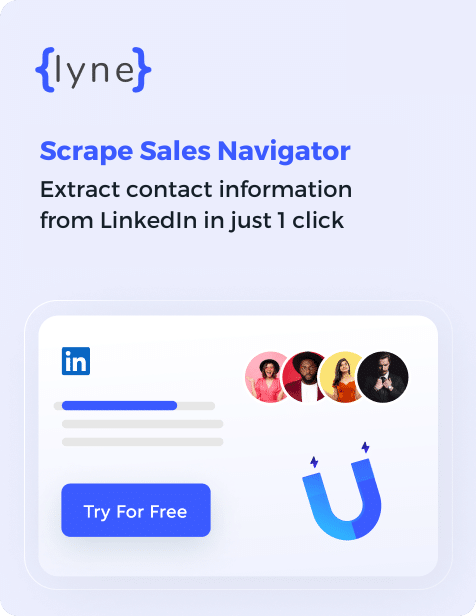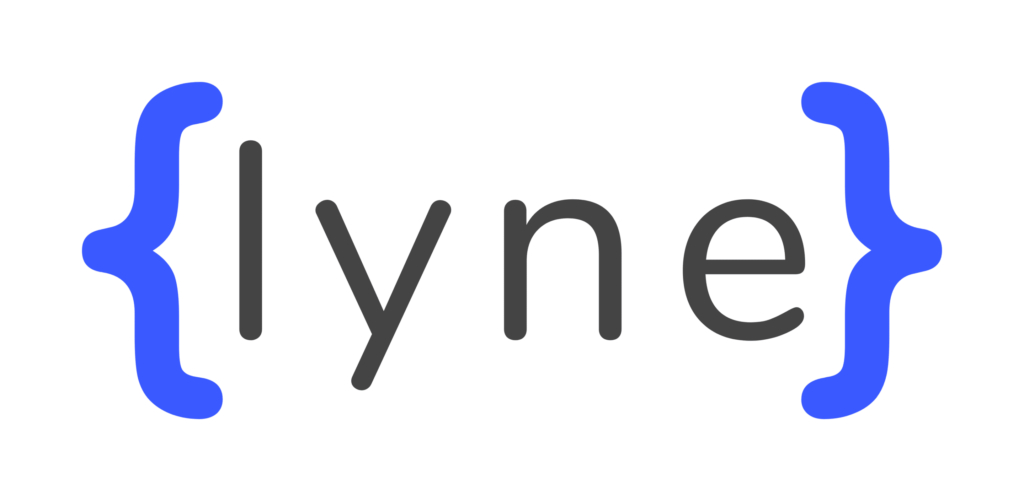Learning how to write a personalized cold email is one of the most important skills you’ll need to learn if you want to sell online. Learning how to do so at scale without having to work another 40 hours per week, that’s a game changer.
In this article you’ll learn:
- The 5-point framework of the perfectly personalized cold email
- Step-by-step workflows and how-to’s for each point
- How to use AI to automate the entire thing
Contents
Why is cold email personalization so important?
People receive hundreds of emails per day, and a large share of those are unsolicited emails trying to sell a service or product.
People have gotten really good at sniffing out the cold emails from the “real” ones. The secret to generating leads through cold outreach is to stand out, be personalized, and to keep it simple.
But if you’re reading this you likely already knew that, so I won’t bore you with the usual stats or facts.
You’ll also know that personalizing cold emails takes time, and a lot of it. In this article I’ll show you exactly how to solve that.
How to personalize a cold email?
Let’s have a look at the 5 different ways of personalizing a single cold email:
Option 1 – Use a relevant & specific subject line (something that’s related to the unique contents of your email)
If your email talks about a case study: {{case_study_company}} case study
If your email is about a blog they’ve written: Your blog on SEO in 2022
If your email is about a podcast they’ve been on: Your talk on The CEO Show
You get the point — if your intro or email talks about a specific topic, make sure that your subject line leads into that. Your prospect will see the subject line + the intro and how they talk about the same thing, which is a pretty powerful thing.

Option 2 – Use a personalized intro or icebreaker to start your email, show you’ve done your research, and capture their attention
This is where you want to show your prospect you’ve done your research (without sounding like a stalker), but you’ll also want to make sure you’re being brief.
The best way to write these intros is to keep the rest of your email in mind. There needs to be a natural flow between your intro, and your email. But more on that later.

Option 3 – Talk about things that are specific to the company or prospect you’re reaching out to. Clients they’ve worked with, articles they’ve written, etc. in the body of your email
“We can help you land more clients just like {{client_1}} or {{client_2}}” (you can get this from the logos and testimonials on their site

Option 4 – Close your email with a highly specific CTA that would only apply to your prospect, their company, or maybe a small group of similar people. If that isn’t possible, use a soft & simple CTA
Best: “If you feel like harvesting a few more clients this quarter…” (sent to someone who mentions his love for farming in his bio)
Good: “Worth an email exchange?” (soft & simple CTA)

Option 5 – Have a PS section that “wows” your prospects — remember that they’ll likely read it first since it draws the attention when opening an email (it’s science)
PS. Read that you went to Cornell -go Big Red! You ever eat at North Star Dining Room?
So now that we’ve gone over the different ways of personalizing a cold email, let’s show you exactly how to set up every single one of those easily and at scale.
How to personalize the subject line for your cold emails
We’ve all heard that subject lines can make or break your campaigns. But hey, no pressure, right?
Luckily for you, if you’re personalizing your emails, coming up with unique subject lines that consistently get 85%+ open rates is easy.
Take the example above for instance. The cold email started with an intro about a case study for Apple this (fictitious) company published on their website. Boom – there’s your subject line: “Apple case study”.
Bet your prospect hasn’t seen that one before. And guess what? Neither have their spam filters.
Talking in your intro about something you read about your prospect or their company? Use it.
Talking in your email about helping them land more clients like Apple? Subject: “more clients like Apple”.
Having a subject line that relates to the first sentence of your email is a superpower not enough people are using yet, so make sure you are to stand out from the rest.
To do this at scale you can either write a short subject line in an additional column as you’re writing your intro lines, or use Lyne.ai to automatically get subject lines based on our AI-generated intros
Read how Email Movers increased their cold email open rates by 200% using Lyne
How to write a personalized icebreaker for your cold emails
Personalized intros or icebreakers have been around for years, but only recently started gaining more popularity. They’re extremely effective since they capture the attention of the reader immediately and start your email off on the right foot when done right.
Some great sources to use for your sales research are:
- LinkedIn profiles
- Blog posts
- Case studies
- Articles, publications, or books written by your prospect
- Events (webinars f.e.)
- Recent news
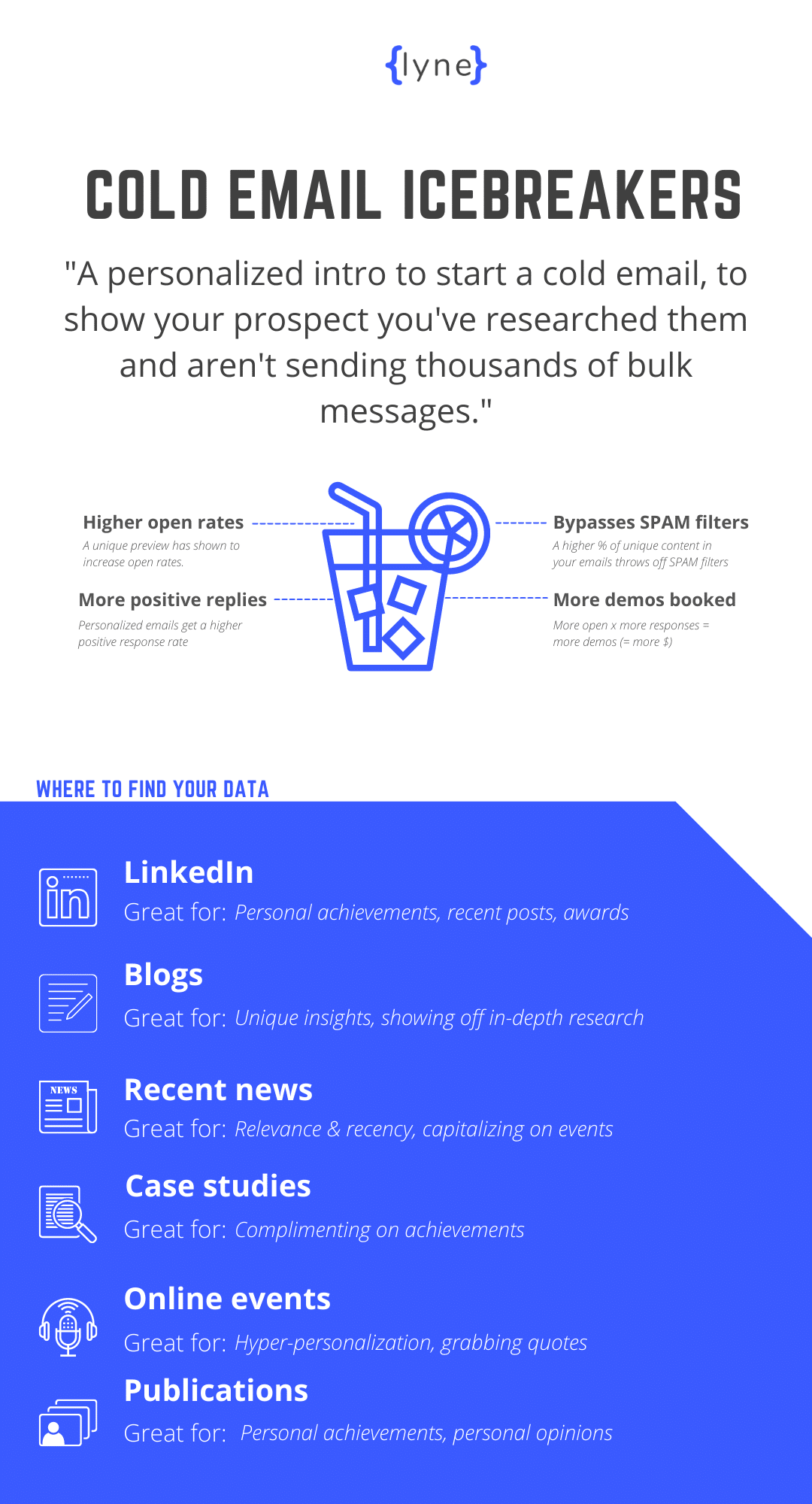
The most common way of doing this at scale is to have a spreadsheet open in one tab, while researching each prospect in a different tab.
You’ll then write a custom intro for each prospect in a column of your spreadsheet, which you can then later use as a {{mergetag}} in your cold email.
The science of a personalized intro
We’ve turned cold email intros into a bit of science, then turned that into a product that produces them at scale.
Back when we were still writing these ourselves we’d work with a “waterfall method” that we still use in our product today.
First, see if the prospect has a website with an about section – that’s where you can usually find some great info on the prospect himself.
Nothing there? Move to their case studies page and see what’s there. If there’s nothing to work with, move on to their LinkedIn profile.
As an example, let’s have a look at an about section for a marketing agency where we want to contact the founder.
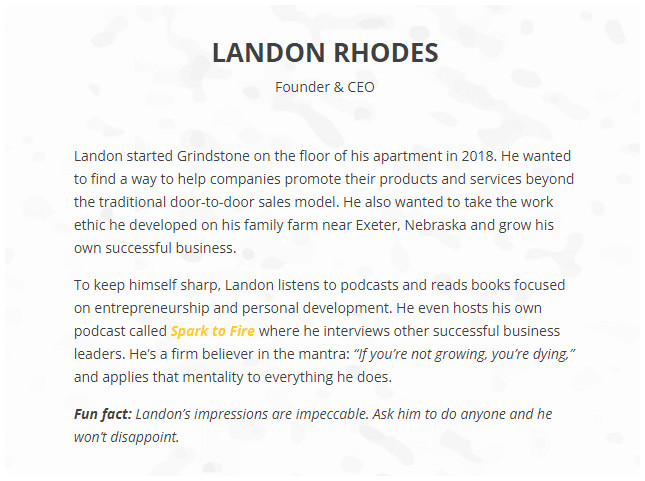
As you can see there’s some great info in here to write a personalized email or intro for.
Here’s how I would personally approach this:
“Hey Landon, fellow (former) farmer here. Love seeing how you’re applying the farmer work ethic to business. I definitely believe it’s unmatched and great to see you’re succeeding because of it.”
To be fair, I’ve taken my own background into account here. If that’s something you’d rather not do, then you can just simply skip that first sentence.
If this company didn’t have an about section on their website, I’d simply move on to their blog or case study page. Nothing there? Moving to LinkedIn.
Despite its effectiveness, it’s a job that you’ll find yourself hating pretty quickly. Which is why hiring a robot is usually the best solution here.
Lyne.ai uses AI and machine learning to do this exact thing, just at a massive scale (and without complaint..). All you’ll need to do is upload a CSV with your prospecting data, which you’ll then have returned with the additional columns attached. Yay AI!

Upload your CSV to your favorite sales automation software and you’re good to go when it comes to sending personalized intros in your cold outreach.
How to write the body of a personalized cold email
Sales is all about relevancy. If you would write a unique email to each and every prospect, this part would be easy.
Just take a look at our first example. We’re able to tie the intro about a case study they published into a pitch for our product.

If you’re okay with sending a few, extremely personalized emails per day, then this isn’t too difficult to accomplish with the right framework. Because in order to write a good cold email, you’ll need a template to work with.
I’m not talking about grabbing the first template you see in the Google search results. What I mean is setting up a framework that you’re using for every single cold email.
Here’s what ours looks like:

Let’s dissect the body part of our framework (2 + 3).
Why you’re reaching out
For the sake of simplicity, I’ll continue with our example from above and finish that email.
“Hey Landon, fellow (former) farmer here. Love seeing how you’re applying the farmer work ethic to business. I definitely believe it’s unmatched and great to see you’re succeeding because of it.
Reason I’m reaching out today is because from experience I know that appointment setting can be a challenge for small marketing agencies. That’s where we come in. We’ve developed an AI-based tool that helps you easily personalize your cold outreach so people love your emails more.
Most of our users see a 200% increase in demo booked rates in their first months.
If you feel like harvesting a few more clients this quarter, would you be interested in learning a bit more?
Thanks,
Hans
PS. How’s your Michael Scott impression?”
Let’s dissect that one shall we.
Why you’re reaching out continued
Move from your intro into the reason you’re reaching out. Keep it short, simple, ideally use industry language. Make sure you’re focusing on 1 main problem or pain point that you’re solving. Never more than 3 sentences. Either 2 medium length ones, or 1 medium length + 2 shorter ones to make for easy reading.
To be fair, this is the part where most people struggle. Not because they have such a hard time explaining why their product is awesome, but rather because they have a problem explaining it in a simple way.
How many cold emails haven’t we received where we had no idea what we were supposed to be buying?
Take Lyne as an example..
“Our product leverages artificial intelligence and machine learning frameworks to help professionals in revenue generating roles to increase email to demo ratios, positively influencing vital demand generation metrics across the board.”
Compared to this:
“Lyne uses AI to write icebreakers for cold email. Most of our users see a 128%+ increase in positive response rates.”
Turns out, writing a simple email is actually pretty darn difficult.
Just make sure you’re reading your email out loud before sending it. Falling over sentences or finding yourself skipping words? Time to go back to the drawing board.
Proof of results
Think of this as a one-line case study. Show proof, ideally mention names, but definitely mention numbers. Talk about increases in percentages or “2x”, and focus on one main thing.
In the example above we talk about improving warm response rates and nothing else, even though our solution also helps increase open rates and much more.
If you can, mention a time frame as well. For example:
“Just last month we helped 24 companies double their cold email open rates.”
“Just last month we helped 24 companies double their cold email open rates in under 3 weeks.”
“Most of the companies we work with see a 200% increase in warm response rates within the first month on our platform.”
Remember how I didn’t go for that final version in our first example? That’s because in section #2 I had two medium-length sentences instead of a mix with shorter ones.
Here’s how that very first email could’ve been written as well:
“Hi Andrew, Hans here. Really enjoyed reading your case study on last year’s SEO project your team did with Apple. Impressed you managed to land them a 300% increase in organic traffic to product pages.
Not to compare apples to oranges, but at Lyne we also help companies increase their campaign performance to help hit growth targets. We use AI to help you hyper-personalize cold emails faster than ever. That means more time to land clients like Apple.
Most of the companies we work with see a 200%+ increase in warm response rates in less than a month after using us.
If you’re not too busy optimizing H-tags, would you be curious to learn a bit more?
Best,
Hans
PS. I see that you went to USF – go Bulls! I’m curious to know how it impacted your career path.
So here’s what the framework looks like when written down:
Hi {{first_name}}, {{sender_first_name}} here. Short intro to show you’ve done your research. Max. 3 sentences, ideally 2 but you could write them a bit differently — like this.
Then here you mention why you’re reaching out. Mix medium-length sentences with shorter ones, to make for easy reading. Talking about two things? Talk about thing 1 & thing 2.
Here you show proof of results in either 1 short sentence, or a slightly longer one.
Then you wouldn’t want to leave your simple CTA out, would you?
Thanks,
{{sender_first_name}}
PS. Make sure to mention something light and maybe even funny right here, they might read it first.
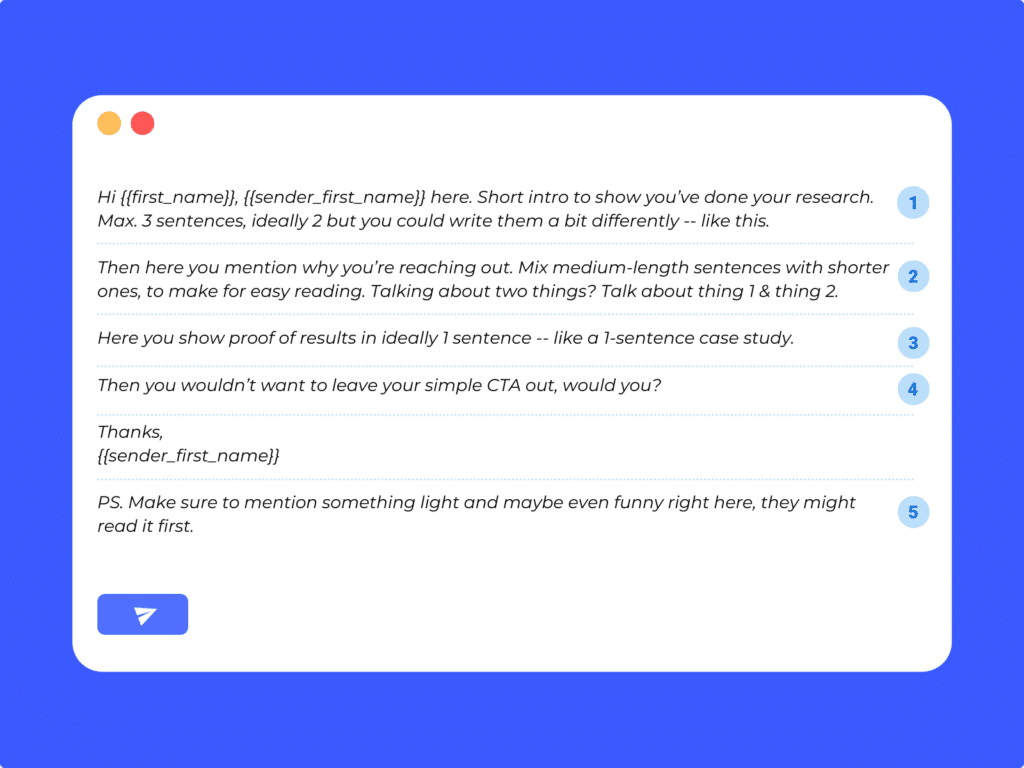
Some other important rules to keep in mind when writing a cold email are:
- Never use more than 150-175 words
- Write simple. Imagine you’re talking to a friend
- Switch up medium length sentences with short ones
- Break the writing rules if you have to. Start sentences with ‘and’ or ‘but’
- Don’t use filler words (purge your emails of them before sending)
- Try to replace ‘and’ with ‘&’ for easier reading
The main benefit of using a strict framework within which you’ll allow yourself for some creativity is that you’ll be able to test what works and what doesn’t.
Because if you’re sending completely different emails every single time, how will you know what works?
By using a framework and tweaking parts of it over time (mixing up the structure, adding an additional sentence, not using an intro but moving personalization to the PS section), you can easily test and measure what works.
How to write relevant cold emails at scale
Doing this at scale is a whole new challenge however. Some small details just aren’t replicable without writing every single email manually.
Sales personalization at scale does mean sacrificing detail to some degree, but with the right strategy you can still write some killer cold emails.
It’s important you take the right approach from the start, all the way back at your targeting and segmentation long before you even write your first draft.
For example, say we’re targeting senior marketing professionals at software companies with 51-1000 employees.
There are so many titles and other variables that come into play that it’s nearly impossible to write one email that would speak to all these different people.

Especially if you plan on using merge tags like {{job_title}} your emails will end up looking robotic and automated.
“Hey David, as a Vice President of Growth Services at Sapper Consulting, LLC do you ever…”
The best way to still allow yourself to write relevant emails, is to segment this way down.
First, the day-to-day life of marketing professionals at firms with 51-100 people will look very different than that of people with the same title at firms with 1000 workers.
The first group will be far more in the trenches themselves, worrying about performance of their campaigns and things like their content calendar.
The second group will be much more focused on making strategic decisions and reporting to the board.
While that doesn’t mean that lowering their CPA by 32% isn’t something they’re not interested in, it probably wouldn’t be right to approach them the same way you would the first group.
Our initial search has over 20k results, which means we still have a lot of room for segmentation. Let’s dive into a few angles you could use here.
Segment by seniority
Probably the most important way of segmenting a broad group like this is by dividing on seniority & company headcount. For all of our examples below, assume we’re doing so unless stated otherwise.
You could make splits of more senior marketing professionals and professionals with manager positions but a bit lower on the ladder. Divide these groups up by company headcount and you have some pretty solid segments down already.
C-level 250+ HC
VP + Director level 250+ HC
Manager 250+ HC
C-level 51-200 HC
VP + Director level 51-200 HC
Manager 51-200 HC
You could then easily write & personalize emails for each segment.
Let’s say we’re reaching out to the VP + Director level 250+ HC segment. What we could do is for each company to grab the name of the marketing executive, or any other marketing colleague, from their LinkedIn page.
That would allow us to send an email that goes something like this:
“Hi {{first_name}}, {{sender_first_name}} here. {{intro}}.
Quick question – is {{colleague_name}} still the one responsible for paid social? Reason I’m asking is because your ad just popped up on my feed and…”
Hyper-personalization achieved. You’re now sending a cold email to a high-level marketing professional, you show you’ve done your research, and he or she will most likely forward your email to that person in question (who will never dare say no to having a call with you now), or they’ll respond themselves.
It’ll require a bit of extra work, but with Phantombuster something like this could be automated pretty easily.
Same goes for the other way around. Just write your pitch around “is {{marketing_leader_name}} breathing down your neck to hit the Q4 targets?”.
Next, make sure that your pitch is now aimed at the specific pain points your newly segmented persona is experiencing and you’re golden.
Want more good news? You now don’t even have to use the {{job_title}} merge tag. Simply go with “as a marketing lead” or “as a senior marketing executive”, or whatever applies to your segment.
Segment by geography + seniority + head count
Another personal favorite is going with the same segmentation above, but also adding a geography based filter. Next, you can then base your email on specifics of that area, or just talk about the weather.
Reaching out to California based prospects? Talk about how your product is “bigger news than Tesla moving their HQ from Cali to Texas”.
Segment by years in position
Some of the most successful campaigns I’ve run when still doing lead gen for clients were based around this.
The intro went something like this: “Having been the marketing manager at {{company_name}} for over {{years_in_position}} now, I’m sure you’ve had plenty of moments where you wanted to {{main_pain_point}}.
Simple but effective. With our Chrome Extension you can grab this info directly from Sales Navigator, find your prospects their email, write a personalized intro for your emails, and reach out. All in just 3 clicks.
Segment by school
This one takes a bit more work, but going after some of the bigger US schools could pay off pretty well for you.
Intros or entire emails written around schools, their mascots, their sports teams, or campus restaurants are a great way to break the ice.
Again, we automate the entire process with our no-touch Lynes.
How to write a good cold email CTA
When your prospect makes it this far, please don’t ruin it by including a Calendly link and asking them to book a demo. We’re past that.
Plenty of research has shown that going with a softer ask yields far better results.
Some examples of softer asks are:
“Mind if I send over a bit more info?”
“Is that something that’s currently on your radar?”
“Is that something that’s relevant right now?”
“What do you think?”
“Curious to learn more?”
“Is that something you’re interested in?”
And so on..
If you can find a way to tie the subject of your email or something personal of the prospect to your CTA, great. If not, don’t sweat it.
A short and to the point CTA is great and easy to set up at scale.
How to use the PS section for killer cold email personalization
This is where you can have a bit of fun, or try and build a connection with your prospect.
Try mentioning their educational background, a local bar, restaurant or sports team, or maybe some industry news.
“Saw that Tesla is moving to your area – excited yet?”
Keep it simple, short, and light. Chances are, your prospect will read this first because a PS section stands out.
If your PS section shows something personalized, the recipient will probably feel a lot better about reading the actual email, instead of a PS section that talks about your product.
Recap
If there’s one thing we’ve learned over the past year or so, it’s that cold outreach and AI are a match made in heaven.
While simple AI-powered improvements such as email confirmation or positive reply detection have already been making our lives easier for years, we’ve only started to scratch the surface of what’s possible when it comes to sales personalization.

Lyne is pioneering that exact space and every day we’re uncovering more exciting use cases. As we’re able to add more advanced functionality to our app, we’re also seeing the results of our users (and of our own cold email campaigns) improve drastically.
As with any tactic; if it’s used too much the effectiveness wears off. Which is why it’s important you keep experimenting and trying different angles & find ways to stand out.
For those of you who aren’t familiar, Lyne.ai uses AI to generate hyper-personalized intros and more for cold outreach.
We help you move beyond {{first_name}} and {{company_name}} and instead send cold emails that feel as if you’ve spent hours researching your prospects online.
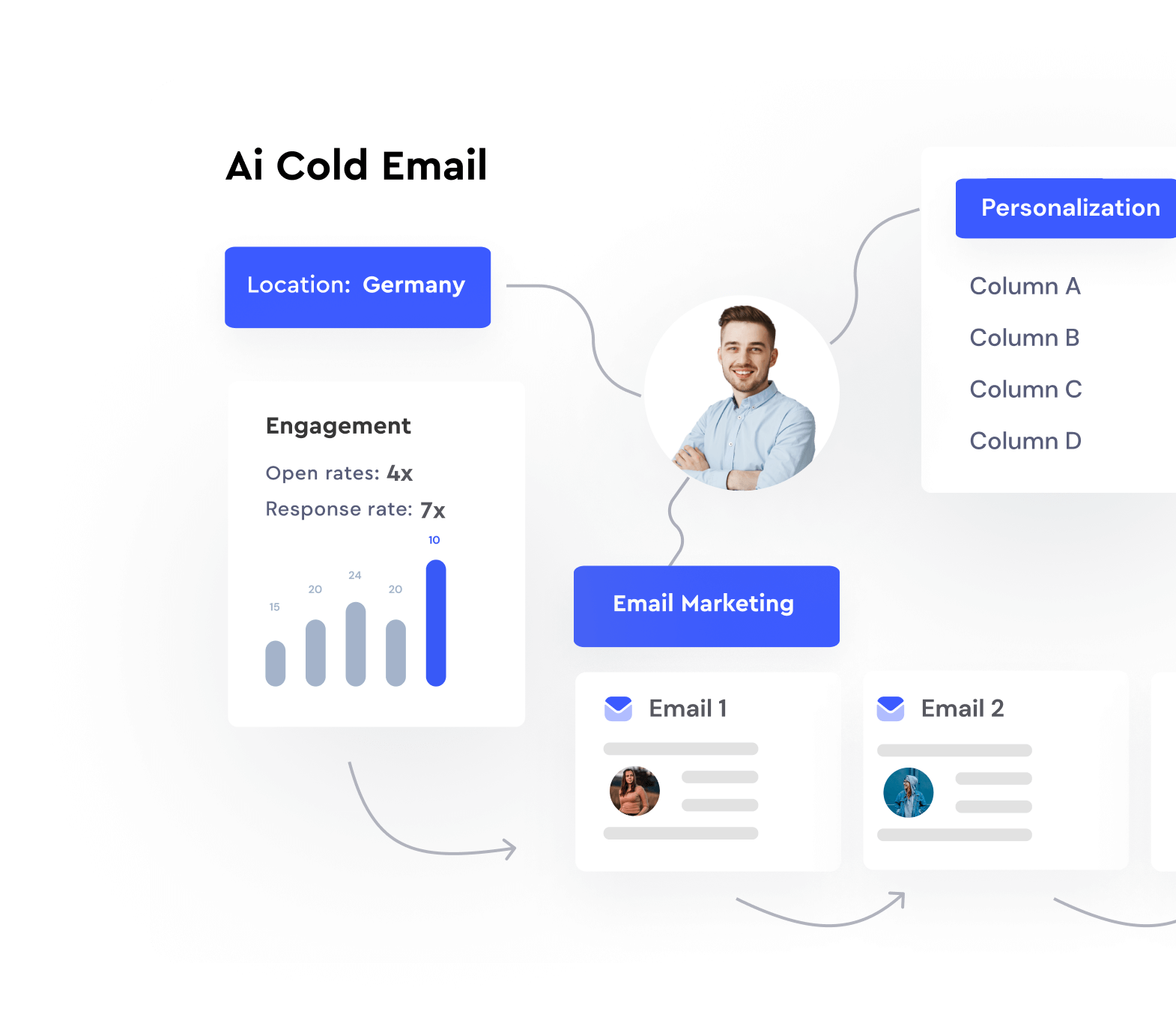
Hey, I’m Hans, Co-Founder and CEO of Lyne.ai. I used to run hundreds of campaigns for clients when I ran my own cold email agency. Having to train and manage that many virtual assistants or SDRs can get very stressful, which is why we built Lyne. Now you can write thousands of personalized first lines for cold emails in less than an hour & all without being locked into a monthly plan.
